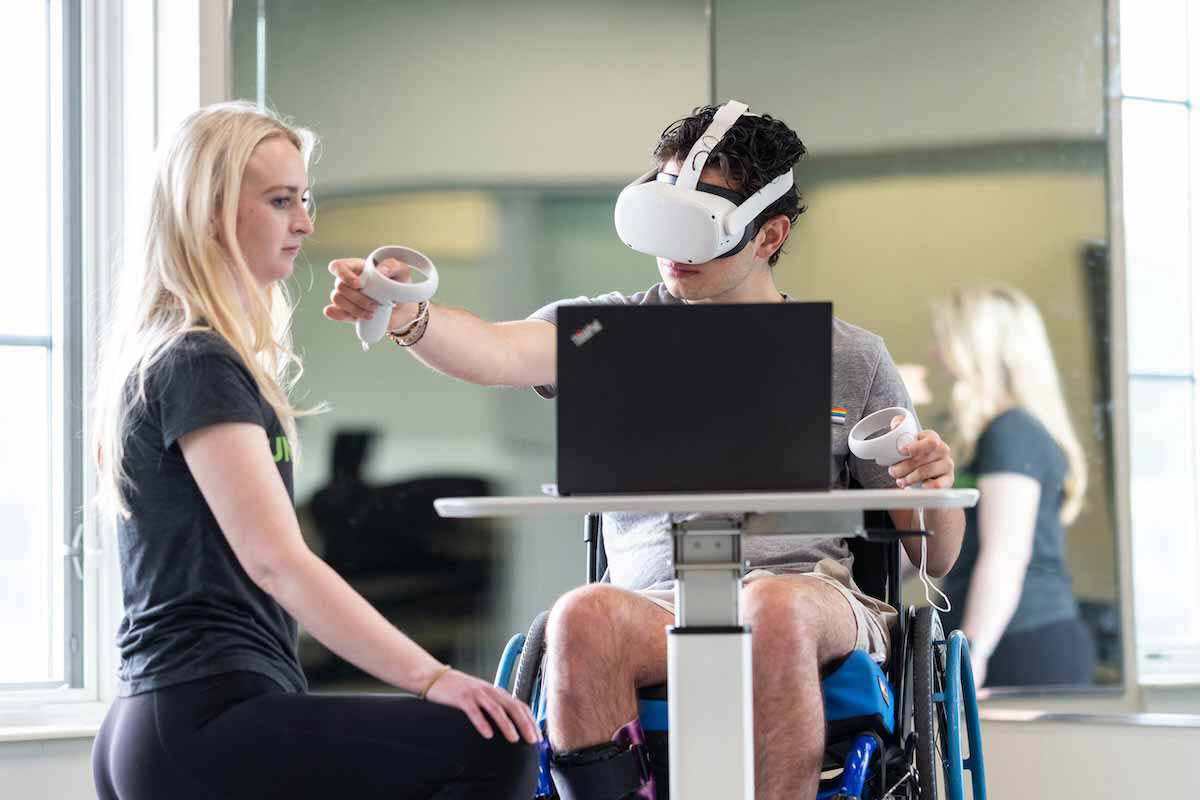Advancing Stroke Rehabilitation Through VR: UNO's Groundbreaking Research
- published: 2024/05/15
- contact: Bella Lockwood (Watson) - Office of Strategic Marketing and Communications
- email: unonews@unomaha.edu
- search keywords:
- virtual reality
- VR
- stroke rehabilitation
- research

The University of Nebraska at Omaha (UNO) is at the forefront of revolutionizing stroke rehabilitation through innovative Virtual Reality (VR) technology. Collaborating between the College of Information Science & Technology and the College of Education, Health, and Human Science’s Department of Biomechanics, researchers aim to enhance therapy outcomes and accessibility for stroke patients.
The Challenge of Stroke Rehabilitation
Every year, over 795,000 individuals in the United States experience a stroke, contributing significantly to long-term disability, according to the Center for Disease Control. Many stroke survivors face compromised mobility, cognitive deficits, and emotional distress presenting multifaceted challenges to rehabilitation.
Traditional methods often lack motivation and personalized treatment plans, leading to low adherence rates among patients. Addressing these challenges demands a comprehensive approach integrating cutting-edge technologies and interdisciplinary collaboration to optimize outcomes and enhance the quality of life for survivors.
Gamifying Rehabilitation with VR
Brian Knarr, Ph.D., an associate professor of biomechanics at UNO, noticed that patients often grew disengaged and bored with their rehabilitation routines. This observation motivated him to explore innovative ways to enhance rehabilitation techniques for both clinicians and patients.
Around this time, VR was gaining popularity and becoming more accessible and user-friendly. Knarr recognized the potential of VR, especially its engaging nature due to its use in gaming. This led him to envision a novel approach: gamifying rehabilitation using VR technology.
Despite his expertise in upper limb rehabilitation, Knarr lacked knowledge of game design and coding. To bridge the gap, he collaborated with Brian Ricks, Ph.D., associate professor of computer science at UNO, who had expertise in this area. Together, with assistance from undergraduate students, they developed a series of VR games specifically designed to aid in the rehabilitation process of stroke survivors.
From popping balloons to throwing paper airplanes, these VR games focus on repetitive movements that are seen in traditional rehabilitation methods, in a more engaging and enjoyable way. The goal was to ensure that rehabilitation remains as effective as possible. The team intentionally designed games and environments to mimic key rehabilitation motions and experiences from the clinical settings. They also ensured that the virtual environment stimulates the brain similarly to real-world activities, despite differences in sensory input.
“Our evidence suggests that VR therapy provides equivalent therapeutic effects to traditional rehab. We've been deliberate in validating the underlying mechanisms of rehabilitation supported by VR to ensure its efficacy,” said Knarr.
One key aspect of their approach was the integration of real-time feedback from clinicians. This enabled them to make instant adjustments to the games as patients progressed, just like they would with real objects during traditional therapy sessions. Clinicians could customize the difficulty level of tasks directly on the screen, ensuring a personalized experience for each patient.
Ricks emphasized the importance of flexibility in their approach, noting that it was crucial to customize games for individual patients' needs. “It became evident that the key challenge wasn't just creating the correct game but ensuring its flexibility. What sets our approach apart is the clinician's ability to customize the game for each patient, adjusting directly on the screen,” he said. “With each iteration, we discover the need for increased flexibility to better meet patient needs.” This constant refinement process, guided by clinician input, led to a VR rehabilitation system that maximizes both technological capabilities and clinician expertise, ultimately benefiting the patients' rehabilitation journey.
Impact and Future Directions
The collaboration with UNO researchers and QLI, a premier rehabilitation center in Omaha, is transforming the landscape of stroke and neurological disorder rehabilitation through the integration of VR games.
Olivia Ollis, an Occupational Therapist at QLI, highlights the impact of VR technology on rehabilitation and its ability to enhance patient engagement and facilitate progress tracking, “Using virtual reality activities noticeably increases engagement. Patients are tracking progress week by week, noting improvements, adjusting the game to target different skills, and integrating therapeutic elements seamlessly.”
At the heart of UNO's VR initiative is the input from the clinician, guiding every stage of development from game design to real-time adjustments. This partnership has led to groundbreaking advancements in stroke rehabilitation, with a focus on formalizing VR game prescriptions, enabling remote therapy sessions, and tailoring game experiences to individual patient needs, particularly in rural areas.
The collaborative efforts between the researchers at UNO and QLI in VR-based stroke rehabilitation represent a significant leap forward in personalized therapy approaches. By leveraging interdisciplinary collaboration, cutting-edge technologies, and real-time clinician feedback, UNO has pioneered a personalized, effective, and enjoyable approach to therapy for stroke survivors. As the initiative continues to evolve, there is optimism for a future where VR games become a standard part of stroke rehabilitation.